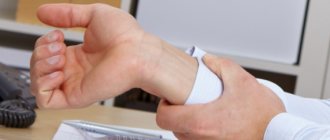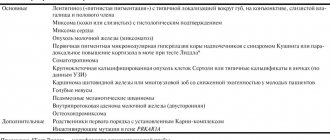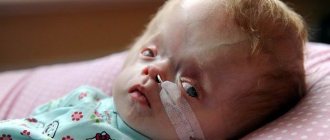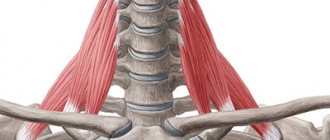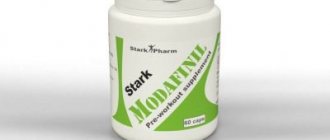Treatment
Angelman syndrome is an incurable genetic abnormality. Currently, medical scientists are actively developing effective therapeutic techniques. If the syndrome was diagnosed during fetal development, experts recommend terminating the pregnancy. A newborn sick child requires careful care, care and highly qualified therapy.
Symptomatic treatment helps alleviate the condition of patients with marionette syndrome. They are prescribed medications and non-drug procedures:
Anticonvulsants reduce the frequency and severity of seizures. Patients are prescribed several anticonvulsants at the same time, since attacks are characterized by several types of seizures. The most popular drugs include: Valproic acid, Convulex, Lamotrigine, Clonazepam. These drugs prevent seizures, improve the mood and mental state of patients. Vitamin therapy is the intake of vitamins B, C, D and E. Treatment with vitamins should only be carried out as prescribed by a doctor, since they reduce the effectiveness of antiepileptic drugs. Sleeping pills that improve sleep in easily excitable patients - Melatonin, Diphenhydramine. When problems with digestion and stool occur, patients are prescribed laxatives – “Senade”, “Slabilen”, “Fitolax”, pre- and probiotics – “Hilak Forte”, “Linex”, “Bifiform”. Hormonal therapy is indicated in extreme cases when it is impossible to correct the behavior of patients in other ways.
They are injected with the hormone secretin, which normalizes digestion and has a positive effect on patients’ attention, as well as oxytocin, which improves the child’s cognitive abilities, memory, and behavior. A similar hormone treatment regimen was developed by American scientists for the treatment of children with autism. For Angelman syndrome, behavioral therapy, work with a psychologist, speech pathologist and speech therapist are indicated. Physiotherapeutic procedures help cope with muscle hypotonia and joint problems
Doctors usually prescribe paraffin baths, electrophoresis, and magnetic therapy. Exercise therapy, professional massage, and aqua gymnastics in cool water help patients stand more confidently on their feet. To get rid of hypersalivation, drugs are used that inhibit salivation and surgical interventions aimed at reimplantation of the salivary ducts. Traditional medicine, like homeopathic medicines, are weakly effective in treating Angelman syndrome, but are absolutely safe. A collection based on peony, licorice and duckweed reduces the frequency of convulsive attacks, a decoction of lavender and an aqueous infusion of motherwort have a general calming effect.
Causes
Angelman syndrome is associated with mental and neurological developmental delays
It is impossible to identify unambiguous factors for the occurrence of pathology in children. In most cases, a change in the composition of chromosome 15 is determined, but the defects in it are of a different nature. In 10% of patients, chromosomal abnormalities are not detected.
Possible changes in chromosome 15:
- deletion, i.e. loss of part of the genetic material. Angelman syndrome is often diagnosed with a 15q12 deletion. This area is associated with the activation of a large number of genes involved in the development of the nervous system and internal organs;
- in 3–5% of pathological cases, geneticists detect uniparental disomy. This is a condition in which the child’s karyotype contains two paternal chromosomes 15. There is no maternal copy;
- In the prenatal period of development, the UBE3A locus, localized on chromosome 15, plays an important role. When it is epigenetically “switched off,” symptoms of the disease develop;
- a mutation in the UBE3A locus is detected in 5–10% of sick children.
Patients with pathology and their parents need consultation with a geneticist. The specialist conducts molecular genetic studies aimed at identifying the cause of Angelman syndrome.
Angelman syndrome - what is it?
This pathology is a congenital disease. It develops in utero. This disorder was first described by a British pediatrician, Dr. Harry Angelman, in 1965. Back then, patients with this diagnosis were called “doll children.” The disease itself was called “happy puppet syndrome.” This disease has other names. One of them is Parsley syndrome. This pathology is accompanied by delayed physical and mental development, walking on straight legs and laughing for no reason. Outwardly, patients with this diagnosis look like dolls.
Angelman syndrome - causes
To this day, scientists are studying the factors that provoke the development of this pathology. Angelman syndrome develops more often, if genetics are disturbed. In other words, the likelihood of its occurrence increases when one of the parents has chromosomal defects. However, Angelman syndrome, Parsley syndrome, and the laughing doll syndrome can also appear spontaneously in a baby whose parents are completely healthy.
The following factors have a teratogenic effect on a child:
- bad habits of a pregnant woman;
- long-term use of psychotropic drugs by parents;
- strong feelings of the expectant mother, provoked by grief or excessive stress;
- an inflammatory process that affects the reproductive system of a pregnant woman;
- stay of the expectant mother in a zone of increased radiation radiation.
Angelman syndrome - type of inheritance
This pathology occurs due to a disturbance in the process of chromosome division. Angelman syndrome has a karyotype of 46 XX or XY. Defects are found in the 15th chromosome. The mutation manifests itself as follows:
- Deletion
is the loss of a piece of chromosome. Patients with this disorder suffer from severe mental retardation. These children in most cases cannot walk or talk. In addition, such patients are often overcome by epileptic seizures. - Duplication
is the appearance of extra genes. If Angelman syndrome is diagnosed, patients are more likely to die in infancy. Sometimes such people survive until puberty. - Inversion
is a defect in which part of a chromosome is missing. In this case, the genes are located in the reverse sequence. - Translocation
- part of a chromosome is attached to another. - Uniparental disomy
is a disorder in which a child inherits two copies of the father's set of chromosome 15. He does not receive maternal benefits.
Causes
Children with this disease always look happy and positive. The syndrome was first described in the 65th year of the 19th century by Harry Angelman, after whom the disease was named. The disease was originally called happy puppet syndrome, but today this name is no longer relevant.
Out of 10-20 thousand infants, the pathology in question is diagnosed in one child. On chromosome 15, copies of the mother's normal genes are lost during chromosome division. Sometimes the syndrome occurs if the father has trisomy, disomy, or if the father's genes are mutated. Healthy children have a copy of chromosome 15 from their father and mother. If the copy is genetically altered, it causes Angelman syndrome.
The onset of the disease is spontaneous, but the risks are higher if one of the parents has a similar disease. If you have a child with Angelman syndrome, this does not mean that the next child will also receive a similar diagnosis (there is a risk, but it is only one percent). The risks of Agnelman syndrome are higher if the parents have any chromosome abnormalities in the body.
Classification and symptoms of pathology
The clinical picture of the lesion is largely determined by the type of genetic defect that causes its occurrence. In medicine, it is customary to distinguish several types of disease:
- Loss of a section of chromosome 15 is the most common form of karyotype leading to symptoms in Angelman syndrome. It is diagnosed in 80% of cases.
- In 5% of patients, there is a loss of part of the maternal genetic information. A section of chromosome 15, which should be obtained from a woman's egg, is replaced with material from the sperm's DNA. This phenomenon is known as paternal disomy.
- Several genes can mutate at once. This problem is registered only in 3–4% of cases. Angelman syndrome in children with a similar defect is caused by disturbances in the imprinting process. This occurs as a result of mutation of the genes that control this mechanism.
- Some patients experience spontaneous formation of the defect. In such cases, a gene located in the child’s brain is transformed. This structure is responsible for the fermentation of proteins. Symptoms develop against the background of a deficiency of this compound.
In 6–8% of cases, it is not possible to determine the type of lesion.
Angelman syndrome is associated with various clinical manifestations, including:
- Retarded mental and physical development. A specific symptom is a decrease in the volume of the skull. A child with Parsley syndrome is difficult to learn, since the disease is associated with disruption of the brain.
- A characteristic sign of defeat is that the baby tends to constantly smile and laugh. However, there are often no reasons for such behavior. Patients appear cheerful and willing to make contact with other children and adults. It is this manner that allows doctors to suspect the presence of a disorder.
- Neurological symptoms are also common. They include tremor, hyperactivity of the upper limb girdle, and a specific gait. Children move in such a way that their legs remain straight. This gave the original name to the pathological condition - happy doll or puppet syndrome. Some patients experience seizures, which worsen their prognosis.
- Language dysfunction is a common problem in children with Angelman syndrome. At the same time, doctors often note a good understanding of the words of others, combined with difficulty expressing their own thoughts. The problem leaves a serious imprint on the social life of patients.
- Deformations of the skull, its cerebral and facial parts are also possible. Children have a massive chin pushed forward, a wide mouth, as well as anomalies in the formation and development of teeth.
It is characteristic that symptoms intensify on average at the age of 5–7 years. In newborns, the clinical picture is in most cases nonspecific and does not allow one to suspect the syndrome. Specific disorders that confirm the diagnosis are noted in the preschool period and are often associated with a lag behind peers in mental and physical development.
The main problem with the disease remains a decrease in communication skills, as well as difficulties in self-care. About 80% of patients with Angelman syndrome express their thoughts in 3–4 words. Children and adults with a genetic abnormality communicate well using gestures, so they widely use them in everyday life. This characteristic only proves relatively high intellectual abilities. Formal languages remain difficult to access, as a result of which the methods of interaction with other people are individual in each case. It has been proven that patients with Engelman syndrome are unable to think abstractly.
Self-care skills also vary. The vast majority of people with a genetic abnormality are able to walk independently, relieve themselves, and use cutlery. Patients learn to communicate food preferences. They may need assistance with bathing and wearing clothes with buttons and zippers. At the same time, many actions performed by patients in everyday life require control. This need is due to the fact that people with Angelman syndrome completely lack a sense of danger. However, with proper support from loved ones, they adapt well to external conditions.
Angelman syndrome: symptoms and signs of the disease
The first signs that parents can pay attention to in infancy are delayed speech and psychomotor development. At the same time, nonverbal skills can be developed much better than verbal ones. Videos of such children can be found on the Internet.
Main symptoms of the disease:
- Very weak weight gain;
- Chaotic movements of arms and legs up to tremor;
- Increased hyperactivity;
- Difficulties with learning and skills;
- Possible deformation of facial features;
- Strabismus;
- Epilepsy attacks.
The above signs do not guarantee the presence of the disease, but only indicate. If most of them match, it is important to contact a geneticist and get tested for karyotype.
A karyotype is a set of all characteristics (number, shape, size) in the complete set of human chromosomes.
The manifestations of some signs of the syndrome may change as they grow older. The most striking sign at any age is a combination of happy behavior and causeless laughter.
Notes
- X-linked mental retardation. (Russian). Center for Molecular Genetics at the Medical Genetic Research Center of the Russian Academy of Medical Sciences. Retrieved May 8, 2021.
- Yamasaki K., Joh K., Ohta T., Masuzaki H., Ishimaru T., Mukai T., Niikawa N., Ogawa M., Wagstaff J., Kishino T.
Neurons but not glial cells show reciprocal imprinting of sense and antisense transcripts of Ube3a. (English) // Human molecular genetics. - 2003. - Vol. 12, no. 8. - P. 837-847. — DOI:10.1093/hmg/ddg106. - PMID 12668607. - Petersen MB, Brøndum-Nielsen K., Hansen LK, Wulff K.
Clinical, cytogenetic, and molecular diagnosis of Angelman syndrome: estimated prevalence rate in a Danish county. (English) // American journal of medical genetics. - 1995. - Vol. 60, no. 3. - P. 261-262. — DOI:10.1002/ajmg.1320600317. - PMID 7573182. - Steffenburg S., Gillberg CL, Steffenburg U., Kyllerman M.
Autism in Angelman syndrome: a population-based study. (English) // Pediatric neurology. - 1996. - Vol. 14, no. 2. - P. 131-136. — DOI:10.1016/0887-8994(96)00011-2. - PMID 8703225.
Treatment
Angelman syndrome is caused by a congenital genetic abnormality; Currently, specific methods for its treatment have not been developed, but some therapeutic measures improve the quality of life of people with the syndrome. Infants with hypotonia should receive massage and other special therapies (physical therapy).
It is recommended to use special methods of child development, classes with a speech therapist and a speech pathologist. Sleep disturbances are corrected by prescribing mild sleeping pills. Dr. Wagstaff (USA) believes that administering 0.3 mg melatonin 0.5 to 1.0 hours before bed improves sleep in patients with Angelman syndrome. Stool disorders are regulated by the administration of mild laxatives.
For seizures, the treatment approach is the same as for epilepsy. Children with Angelman syndrome often have more than one type of seizure. Electroencephalography is indicated.
Undesirable behavior requires correction. Dr. Charles Williams (Gainesville, Florida), who works primarily with autistic children, notes common behavior patterns among autistic children and children with Angelman syndrome: marked self-stimulation, impulsivity, compulsive, repetitive movements, interest in inappropriate objects, and difficulty in communicating with other people. US doctors report that in autistic children, intravenous injections of the hormone secretin (found in the pancreas) successfully reduce unwanted behavior and promote good levels of sociability and communication skills; Perhaps medicine will come to the use of secretin to correct the behavior of children with Angelman syndrome.
Giovanni Francesco Caroto (c. –). Portrait of a red-haired boy with a drawing of a jointed doll
Treatment of the syndrome
Due to the fact that the pathology occurs at the chromosomal level, treatment with medications does not bring any positive results.
Science has not yet developed a method for treating such patients, but there are still special measures with which you can slightly improve the patient’s life.
To slightly correct hypotension, the child is prescribed therapeutic massage and strengthening physiotherapy from childhood.
In order for the child to speak more clearly, he must be taken to classes with a speech therapist. To support the patient in a normal state, he is prescribed different types of therapy: behavioral, communicative psychotherapy.
So, the main thing is that from childhood it is advisable to treat the patient with love, to provide him with care and good care.
Angelman syndrome causes
In this disease, certain genes on chromosome 15 are missing. Most cases are characterized by a partial deletion or mutation of chromosome 15. With Angelman syndrome, the maternal chromosome is affected, and in case of changes in the paternal chromosome, Prader-Willi syndrome develops. Often the syndrome is caused by a spontaneous chromosomal defect, which is characterized by the absence of a contiguous region consisting of four million base pairs of DNA in places q11-q13 of the 15th chromosome.
Angelman syndrome has a karyotype of 46 XX or XY, 15r. Independent studies identify mutations in the UBE3A gene as the causes of Angelman syndrome. The enzymatic component of a complex protein degradation system is considered the product of this gene.
Parsley syndrome: illness and life prognosis
Life prognosis and severity of the disease depend on the severity of symptoms. In each specific case the situation may be different.
So some children with a milder form of the disease may:
- Be able to control yourself;
- Process information better;
- Have a large vocabulary smell.
In another case, the child may have more problems with intelligence, but at the same time be well physically developed. The severity of the disease is influenced by whether there are epileptic seizures or not.
Early initiation of restorative therapy and the use of physical procedures significantly reduces the manifestation of the disease and improves life prognosis.
There are also genetic studies that indicate that a certain type of mutation in genes has different effects on the diagnosis and course of the disease. Thus, changes in the UBE3A gene lead to the least changes in the body, while large rearrangements in chromosome 15 can greatly affect the condition of a sick child.
How is Angelman syndrome treated?
This is a genetic disease and, unfortunately, scientists have not yet found methods to treat it. But there are techniques that make life easier for such people and significantly improve their quality of life.
In each individual case, with a disease such as Angelman syndrome in children, the symptoms will be different. Therefore, an individual therapy method is developed for each patient.
There are several types of therapeutic treatment, they are as follows.
- Since Angelman syndrome is characterized by seizures, convulsions, and epileptic attacks, antiepileptic drugs, or anticonvulsants, are recommended. They will significantly reduce the manifestations of these symptoms and allow you to control the patient’s condition.
- Impaired motor skills and problems with motor functions are also symptoms of Angelman syndrome. Physical therapy classes and special training designed for such patients are necessary for their development. You need to do the exercises regularly and patiently, and then the work will be rewarded. Such children develop slowly, but with the patience of their parents a lot can be achieved.
Special classes help children with Angelman syndrome adapt to the outside world
Children with hypotension should be prescribed massage and special physiotherapeutic procedures. If a child has Angelman syndrome, treatment must include sign language. This will be very useful, both for them in further communication with people, and for the mothers and fathers themselves. Classes with a speech pathologist and speech therapist are recommended. Specially designed programs help to correctly and effectively teach children the rules of etiquette and behavior in society
They are designed to help patients cope with increased activity and learn to concentrate their attention. After undergoing such therapy, patients will find it easier to communicate with peers, and some can even start their own families. It is necessary to take a more careful approach to the preparation of the diet, since obesity is very often observed in such children, especially in girls.
In the presence of Angelman syndrome, metabolic processes in the body are disrupted, which can often lead to excess body weight with normal nutrition
- In such patients, as a rule, the stool is disturbed; in this case, laxatives are prescribed.
- For sleep disturbances, mild sleeping pills are prescribed.
Scientists have noticed that Angelman syndrome is very similar to a disease such as autism.
Symptoms of Angelman syndrome
Manifestations of the disorder in the psycho-emotional sphere:
- developmental delay, including absence of babbling and crawling between 6 months and 1 year;
- learning disability;
- lack of speech or minimal speaking skills;
- unmotivated frequent laughter/smiling;
- the personality type can be described as joyful, exalted.
Symptoms of the disorder at the somatic level:
- seizures of epilepsy, which usually occur between the ages of 2 and 3 years;
- difficulty walking/moving, stiff or sharp angular movements due to the inability to control voluntary movements (ataxia);
- unusual behavior such as sudden flapping of arms, walking with raised arms and/or stiff legs;
- small head size with flattening in the occipital area (microbrachycephaly);
- hair, skin and eyes of a light shade (hypopigmentation);
- Sometimes children have a wide mouth, sparse teeth and a protruding tongue. In most cases, patients' facial features do not differ in anything unusual.
Separately, we should dwell on the features of speech development and motor skills characteristic of people with Angelman syndrome.
Most children with this disorder have an extremely poor vocabulary, which may be limited to a few words (up to one or two dozen). This causes significant difficulties in the socialization of a child who has Parsley syndrome.
At the same time, children with such a disorder - as a rule - understand not only simple commands, but are also able to absorb information in a volume that significantly exceeds their ability to communicate and express thoughts.
As for motor skills, in addition to the manifestations described above, “Parsley” children can often hold their arms raised and bent at the elbows and wrists, and periodically wave their arms in moments of excitement or while walking. It was this similarity to the movements of a puppet, coupled with their angularity and stiffness against the background of the patients’ frequent exaltation, that became the reason for calling the disorder happy doll syndrome.
They may experience both decreased muscle tone in the trunk (hypotonia) and increased muscle tone in the extremities (hypertension), as well as abnormally exaggerated reflex reactions (hyperreflexia). Some children develop fine tremors in the arms and legs. These disorders may appear between 6 months and 1 year of age.
The acquisition of some milestone motor skills, such as walking, is delayed.
In cases of relatively mild forms of the disease, children can begin to walk at 2-3 years of age. In more severe cases, upright walking is slowed down and occurs jerkily - “rigidly”, which also resembles the movements of a puppet. Some children do not walk until they are 5 to 10 years old. Approximately 10% of patients are unable to move without assistance.
Symptoms
Main manifestations of the syndrome:
- poor weight gain
- poor appetite
- delayed or absent speech
- developmental delays
- the child understands thoughts normally, but cannot express his thoughts
- chaotic movements of the arms or legs (this may be a tremor, and not a full movement)
- hyperactivity
- significant learning difficulties
- a sick child cannot concentrate sufficiently
- there may be deformed facial features (large chin pushed forward, wide mouth, sparsely spaced teeth)
- Children with this syndrome often suffer from epilepsy
- smiles and laughter for no reason
- the child walks on straight legs, without bending them, like a puppet (that’s why the old name of the syndrome is exactly as noted above)
- strabismus
- flattening of the occiput
- scoliosis
- sleep problems
- small head
- increased sensitivity to heat
The above listed signs are not necessarily fully present in a sick child. Some of them may be very clearly visible, while some may be absent. Mental and physical development is always delayed. Speech problems are also very characteristic of the syndrome in question. And convulsions and changes in the normal shape of the head occur in more rare cases.
Very rare symptoms of Angelman syndrome:
- protruding tongue that trembles
- lower jaw pushed forward
- eating disorder
- overactive tendon reflexes
- strabismus
- uncontrollably moving tongue
- disturbance of sucking and swallowing reflexes
Manifestations of the syndrome may change as the child grows older. In adulthood, patients look younger than their age. Puberty does occur at a certain point, so their reproductive function is fine. Such patients may have children of their own. But there is a very high risk that their child will be diagnosed with the same disease.
In adulthood, with the diagnosis under consideration, a person may have impaired fine motor skills and urinary incontinence. They mostly wear clothes without fasteners because they cannot dress themselves due to motor impairment. Household skills are sufficiently mastered by patients. They can eat themselves, brush their teeth, wash things, etc. without outside help. In most cases, living to adulthood, patients become obese and have severe scoliosis, which worsens over the years.
The vocabulary of sick children is very small. Some of them don't speak at all. Character traits such as friendliness and sociability are inherent. Children love their relatives and show affection. It is advisable to teach a child to communicate through sign language from an early age. For this purpose, special training programs have been created. They help the child improve motor skills in order to serve himself at home and work.
Treatment
There is no modern means of preventing and getting rid of parsley (doll) syndrome. There is no treatment for Angelman syndrome today due to the fact that the causes of the genetic defect are unknown. A set of measures has been developed aimed at stabilizing and improving the quality of life in this disease. The rehabilitation program is developed individually, but some of the measures are common to all patients:
- Taking anticonvulsants and antiepileptic drugs.
- Therapeutic preventive physical education, massage, physiotherapy. Helps stabilize general motor skills, improve the functioning of the musculoskeletal system, and teach walking naturally (pictured).
- Learning sign language. Many patients with parsley syndrome use a less than average range of words in conversation, but do not have learning difficulties. Sign language becomes an acceptable alternative in communication if taught from early childhood (pictured).
- Behavior therapy. This method is aimed at compensating for attention deficit, eliminating or suppressing hyperactivity, and providing the opportunity to provide correct education for adaptation in society.

